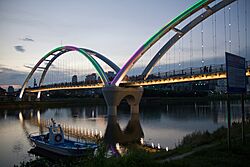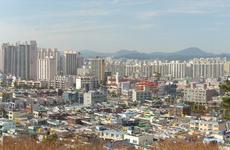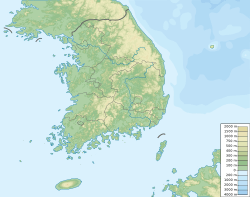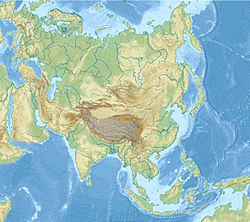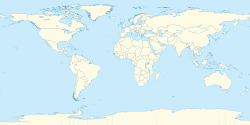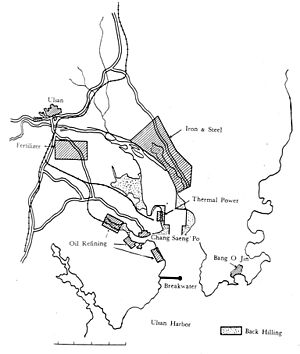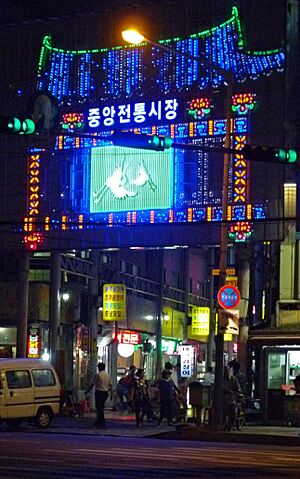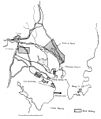Ulsan facts for kids
Quick facts for kids
Ulsan
울산시
|
|||
|---|---|---|---|
|
Metropolitan City
|
|||
| transcription(s) | |||
| • Hangul | 울산광역시 | ||
| • Hanja | 蔚山廣域市 | ||
| • Revised Romanization | Ulsan gwang-yeoksi | ||
| • McCune-Reischauer | Ulsan gwangyŏksi | ||
|
Downton Ulsan, Ulsan aerial view, Simnidaebat Bridge, Gajisan Provincial Park and Daewangam Park
|
|||
|
|||
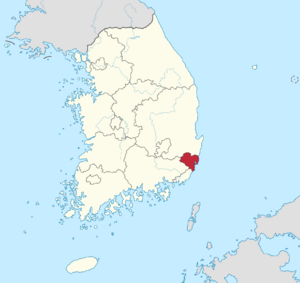 |
|||
| Country | |||
| Region | Yeongnam | ||
| Districts | 5 (including 1 county) | ||
| Government | |||
| • Type | Mayor–Council | ||
| Area | |||
| • Total | 1,057.136 km2 (408.162 sq mi) | ||
| Population
(October, 2022)
|
|||
| • Total | 1,111,707 | ||
| • Rank | 8th Korea | ||
| • Density | 1,051.6216/km2 (2,723.6873/sq mi) | ||
| • Dialect | Gyeongsang | ||
| Demonym(s) | Ulsanian | ||
| GDP | |||
| • Total | KR₩ 86 trillion US$ 69 billion (2022) per capita US$ 63,017 (2023) |
||
| Area code(s) | +82-52(2) | ||
| ISO 3166 code | KR-31 | ||
| Flower | Pear flower | ||
| Tree | Ginkgo | ||
| Bird | White heron | ||
Ulsan (Korean pronunciation: [uɭ.s͈an]), officially called the Ulsan Metropolitan City, is a large city in South Korea. It is the seventh-largest metropolitan city and the eighth-largest city overall in the country. More than 1.1 million people live here. Ulsan is located in the southeast of South Korea. It is next to Busan in the south and faces Gyeongju to the north.
Ulsan is known as the industrial heart of South Korea. It has some of the world's biggest factories. For example, it has the largest automobile assembly plant, run by Hyundai Motor Company. It also has the world's largest shipyard, run by Hyundai Heavy Industries. Plus, it's home to the world's third largest oil refinery, owned by SK Energy. In 2020, Ulsan had the highest GDP per capita (money earned per person) of any region in South Korea, at $65,352.
Contents
Ulsan's City Divisions
Ulsan is divided into different areas to help manage the city. It has four gu (districts) and one gun (county). These are like different neighborhoods or regions within the city.
- Buk District (북구; 北區)
- Dong District (동구; 東區)
- Jung District (중구; 中區)
- Nam District (남구; 南區)
- Ulju County (울주군; 蔚州郡)
Ulsan's Long History
Ulsan has been home to people for a very long time.
- Ancient Times: Stone tools found in Ulsan show that people lived here as early as the Stone Age. More discoveries prove human life during the New Stone Age and Bronze Age.
- Iron Age: During the Jinhan confederacy, Ulsan was a key place for mining and making iron.
- Silla Period: In the Later Silla period, Ulsan was an important port. It helped bring fancy goods from places like Persia to Gyeongju, a major economic center.
- Joseon Dynasty: Records from the Joseon Dynasty show that Ulsan started building ships as early as 1642.
- Battles and Growth: In 1592, warrior monks and citizens fought bravely against a Japanese invasion near Ulsan's port. Later, in 1598, Korean and Chinese forces tried to take a castle here but did not succeed.
- Modern Industrial Hub: Ulsan grew a lot as an industrial center because of the two World Wars. In 1962, it was chosen to be a Special Industrial Zone. The next year, it officially became a city. Big companies like Hyundai Group and SK Group built major businesses here. This quickly turned Ulsan into a modern, busy city.
Ulsan's Geography and Climate
Ulsan is located about 70 km (43 mi) north of Busan. It has a special type of weather called a monsoon-influenced humid subtropical climate. This means it has cold, dry winters and hot, humid summers.
Ulsan's Weather Details
The average temperature in January is about 2.0 °C (35.6 °F). In August, the warmest month, it averages around 25.9 °C (78.6 °F). The temperature usually doesn't change too much between day and night. The hottest days are often in August, reaching close to 30 °C (86 °F). Ulsan gets less rain in winter but a lot of rain from April to September.
| Weather chart for Ulsan | |||||||||||||||||||||||||||||||||||||||||||||||
|---|---|---|---|---|---|---|---|---|---|---|---|---|---|---|---|---|---|---|---|---|---|---|---|---|---|---|---|---|---|---|---|---|---|---|---|---|---|---|---|---|---|---|---|---|---|---|---|
| J | F | M | A | M | J | J | A | S | O | N | D | ||||||||||||||||||||||||||||||||||||
|
39
7
-2
|
40
10
-0
|
68
14
4
|
97
19
9
|
107
24
13
|
156
26
18
|
234
29
22
|
234
30
23
|
170
26
18
|
75
22
12
|
44
16
6
|
28
10
-0
|
||||||||||||||||||||||||||||||||||||
| temperatures in °C precipitation totals in mm |
|||||||||||||||||||||||||||||||||||||||||||||||
|
Imperial conversion
|
|||||||||||||||||||||||||||||||||||||||||||||||
| Climate data for Ulsan (1991–2020 normals, extremes 1932–present) | |||||||||||||
|---|---|---|---|---|---|---|---|---|---|---|---|---|---|
| Month | Jan | Feb | Mar | Apr | May | Jun | Jul | Aug | Sep | Oct | Nov | Dec | Year |
| Record high °C (°F) | 19.3 (66.7) |
24.2 (75.6) |
25.4 (77.7) |
31.0 (87.8) |
34.7 (94.5) |
35.5 (95.9) |
38.2 (100.8) |
38.8 (101.8) |
35.6 (96.1) |
30.5 (86.9) |
27.6 (81.7) |
22.4 (72.3) |
38.8 (101.8) |
| Mean daily maximum °C (°F) | 7.4 (45.3) |
9.6 (49.3) |
13.7 (56.7) |
19.3 (66.7) |
23.7 (74.7) |
26.1 (79.0) |
29.2 (84.6) |
30.0 (86.0) |
26.0 (78.8) |
21.8 (71.2) |
15.9 (60.6) |
9.6 (49.3) |
19.4 (66.9) |
| Daily mean °C (°F) | 2.4 (36.3) |
4.3 (39.7) |
8.4 (47.1) |
13.7 (56.7) |
18.2 (64.8) |
21.6 (70.9) |
25.2 (77.4) |
26.0 (78.8) |
21.7 (71.1) |
16.5 (61.7) |
10.4 (50.7) |
4.3 (39.7) |
14.4 (57.9) |
| Mean daily minimum °C (°F) | −1.8 (28.8) |
−0.3 (31.5) |
3.5 (38.3) |
8.5 (47.3) |
13.4 (56.1) |
17.7 (63.9) |
22.1 (71.8) |
22.8 (73.0) |
18.2 (64.8) |
12.1 (53.8) |
5.7 (42.3) |
−0.1 (31.8) |
10.2 (50.4) |
| Record low °C (°F) | −14.3 (6.3) |
−12.5 (9.5) |
−9.6 (14.7) |
−2.6 (27.3) |
3.6 (38.5) |
6.8 (44.2) |
13.9 (57.0) |
13.4 (56.1) |
7.9 (46.2) |
0.4 (32.7) |
−7.8 (18.0) |
−12.4 (9.7) |
−14.3 (6.3) |
| Average precipitation mm (inches) | 38.6 (1.52) |
39.9 (1.57) |
68.4 (2.69) |
96.9 (3.81) |
107.4 (4.23) |
155.5 (6.12) |
234.1 (9.22) |
234.1 (9.22) |
170.3 (6.70) |
74.8 (2.94) |
44.2 (1.74) |
28.4 (1.12) |
1,292.6 (50.89) |
| Average precipitation days (≥ 0.1 mm) | 5.5 | 6.0 | 8.2 | 8.8 | 9.3 | 10.0 | 13.6 | 12.7 | 10.5 | 5.8 | 5.9 | 4.5 | 100.8 |
| Average snowy days | 1.8 | 2.1 | 0.9 | 0.0 | 0.0 | 0.0 | 0.0 | 0.0 | 0.0 | 0.0 | 0.1 | 1.2 | 6.1 |
| Average relative humidity (%) | 48.5 | 50.5 | 56.1 | 59.1 | 64.6 | 73.5 | 78.6 | 77.7 | 75.8 | 67.1 | 60.0 | 50.9 | 63.5 |
| Mean monthly sunshine hours | 192.8 | 184.4 | 200.9 | 213.1 | 221.4 | 171.9 | 155.7 | 175.8 | 159.0 | 196.4 | 183.6 | 194.5 | 2,249.5 |
| Percent possible sunshine | 61.2 | 57.4 | 50.6 | 52.8 | 49.5 | 39.6 | 34.2 | 40.0 | 40.3 | 55.3 | 58.8 | 64.0 | 49.2 |
| Average ultraviolet index | 2 | 3 | 3 | 4 | 5 | 5 | 7 | 6 | 5 | 4 | 3 | 2 | 4 |
| Source 1: Korea Meteorological Administration (percent sunshine 1981–2010) | |||||||||||||
| Source 2: Weather Atlas (UV) | |||||||||||||
Ulsan's People and Beliefs
Religion in Ulsan (2015) Not religious (54.5%) Buddhism (29.8%) Protestantism (10.9%) Catholicism (4.2%) Other (0.6%)
In 2015, most people in Ulsan did not say they belonged to any religion. Among those who did, Buddhism was the most common, followed by Protestantism and Roman Catholicism.
Ulsan's Strong Economy
Ulsan is a very important industrial city. It is the main center of the Ulsan Industrial District. This city is the home base for the huge company group called Hyundai.
Before 1962, Ulsan was mostly a fishing port and a market town. But as part of South Korea's first big economic plan, Ulsan became an open port. The government also made Ulsan a Special Industrial District. This helped big factories and plants grow there. An oil refinery, fertilizer plants, car factories, and other heavy industries were built. The shipbuilding port of Bangeojin became part of the city in 1962.
Major Industries in Ulsan
- Hyundai Heavy Industries: This company built a huge shipyard in Ulsan in 1973. This made Ulsan a "company town" and brought many workers to the city. Hyundai's importance is clear because many things in the city, like a highway, hospital, school, and stores, are named after Hyundai.
- Oil Refineries: Ulsan has the world's third largest oil refinery, which processes 840,000 barrels of oil per day. It is owned by SK Energy. Another large refinery, S-oil, is also in Ulsan. It is owned by Saudi Aramco.
- Hyundai Motors: Ulsan is home to the world's largest automobile assembly plant. It can make 1,700,000 cars each year. This plant started small in 1968 and has grown a lot. It even has its own docks to ship cars around the world.
- Battery Production: In 2011, a company called SB LiMotive opened a factory in Ulsan to make advanced lithium-ion batteries. Later, Samsung SDI took full ownership of this factory. It is now one of Samsung SDI's main car-battery production sites.
Getting Around Ulsan
Ulsan has a good public transportation system, just like other big Korean cities. The bus system even tells you when the next bus will arrive at most stops.
- Ulsan Airport: This airport was built in 1970. It has many flights every day to and from Seoul's Gimpo International Airport. There are also flights to Jeju International Airport.
- High-Speed Train (KTX): In 2010, the KTX high-speed train network reached Ulsan. This train connects Ulsan to Seoul in just over 2 hours. The new KTX station, Ulsan Station, is outside the city center in Eonyang. Special express buses connect the station to the city. The old city train station is now called Taehwa River Station.
- Future Plans: The city is planning to build a light-rail line to make travel even easier.
Sports in Ulsan
Ulsan is home to several sports teams.
- Football: The city has a professional football club called Ulsan HD FC, which plays in the K League 1. They play their home games at the Munsu Stadium. This stadium also hosted matches during the 2002 FIFA World Cup. Ulsan HD FC has won the AFC Champions League (Asia's top club competition) twice, in 2012 and 2020. Another football team, Ulsan Citizen FC, plays in the K3 League.
- Basketball: Ulsan also has a professional basketball team, Ulsan Hyundai Mobis Phoebus. They play in the Korean Basketball League at the Dongchun Gymnasium.
- Baseball: The Lotte Giants, a baseball team from Busan, sometimes play their home matches at the Ulsan Munsu Baseball Stadium.
- University Sports: The University of Ulsan also has its own sports programs.
Fun Places to Visit in Ulsan
Ulsan has many interesting places for visitors to enjoy.
- Yeongnam Alps: This area has seven tall mountains, each over 1,000 meters high. The Sinbulsan Ridge is famous for its silver grass in autumn. The Eoksae festival, celebrating this silver grass, happens every October.
- Oegosan Onggi Village: This is Korea's largest traditional folk Onggi (earthware) village. You can see how traditional pottery is made and even try making some yourself. The Ulsan Onggi Museum teaches you all about this special earthware.
- Jangsaengpo Whale Museum: This is the only whale museum in Korea. It shows items related to whaling, which became rare after whaling was banned in 1986 to protect whales. The museum teaches about whales and ocean life. You can even take a whale cruise from Jangsaengpo port.
- Ulsan Grand Park: This is a huge park in the middle of the city, covering 3.64 million square meters. It's designed to be natural, clean, and comfortable, offering a peaceful escape for city residents. The park hosts many events and festivals, including a beautiful Rose Festival every June.
- Taehwagang National Garden: This garden includes the Simnidaesup, a ten-ri (about 4 km) bamboo grove. The river and bamboo grove are now connected, showing the importance of nature. It's a great place to see wildlife and relax.
- Beaches and Capes: Ulsan has lovely beaches like Jinha and Ilsan. Daewangam Park has a beautiful old pine forest. Ganjeolgot Cape is famous as the first place in Korea to see the sunrise. A special sunrise festival is held there every New Year's Day.
Ulsan's Exciting Festivals
Ulsan hosts several fun festivals throughout the year.
- April: Seo Duk-chul Original Children's Song Competitions
- July ~ August: Ulsan Summer Festival
- December 31 ~ January 1: Ganjeolgot Sunrise Festival
Ulsan's Sister Cities
Ulsan has special connections with cities around the world, called "sister cities." These connections help promote friendship and understanding.
| City | Region | Country | Year |
|---|---|---|---|
| Hagi | Yamaguchi Prefecture | 1981 | |
| Portland | Oregon | 1987 | |
| Changchun | Jilin | 1994 | |
| Kocaeli Province | 2002 | ||
| Santos | São Paulo | 2002 | |
| Khánh Hòa Province | 2002 | ||
| Tomsk | Tomsk Oblast | 2003 | |
| Wuxi | Jiangsu | 2006 | |
| Montevideo | Montevideo Department | 2012 | |
| Chennai | Tamil Nadu | 2016 | |
| Mandalay | Mandalay Region | 2017 | |
| Houston | Texas | 2021 |
Famous People from Ulsan
Many talented people come from Ulsan, including actors, singers, and athletes.
- Kim Young-chul, comedian and singer
- Kim Tae-hee, actress
- Han Chae-ah, actress
- Oh Yoon-ah, actress
- Raina, singer (After School and Orange Caramel)
- Tei, singer
- Seo In-guk, singer and actor
- Yura, singer (Girl's Day)
- Jang Ki-yong, model and actor
- Kim Min-kyu, actor and former Produce X 101 contestant
- Yumdda, rapper
- Lee Wan, actor
- Han So-hee, actress
- Lee So-hee, badminton player
- Kim Su-ji, diver
- Bibi, singer
- Kim Seung-gyu, football player
- Jung Woo-young, football player
- Lee Jae-sung, football player
- Seol Young-woo, football player
Images for kids
See also
 In Spanish: Ulsan para niños
In Spanish: Ulsan para niños


